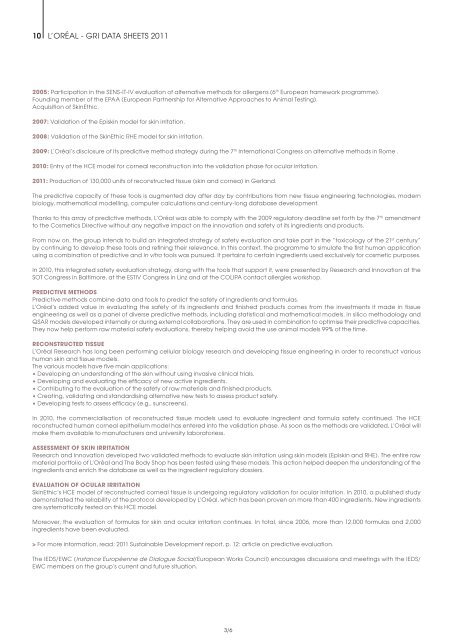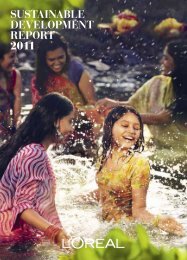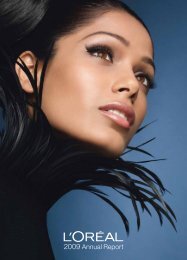Organizational Strategy - Sustainable Development - L'Oréal
Organizational Strategy - Sustainable Development - L'Oréal
Organizational Strategy - Sustainable Development - L'Oréal
You also want an ePaper? Increase the reach of your titles
YUMPU automatically turns print PDFs into web optimized ePapers that Google loves.
10 L’oréaL - GrI DaTa SHEETS 2011<br />
2005: Participation in the SENS-IT-IV evaluation of alternative methods for allergens (6 th European framework programme).<br />
Founding member of the EPaa (European Partnership for alternative approaches to animal Testing).<br />
acquisition of SkinEthic.<br />
2007: Validation of the Episkin model for skin irritation.<br />
2008: Validation of the SkinEthic rHE model for skin irritation.<br />
2009: L’oréal’s disclosure of its predictive method strategy during the 7 th International Congress on alternative methods in rome .<br />
2010: Entry of the HCE model for corneal reconstruction into the validation phase for ocular irritation.<br />
2011: Production of 130,000 units of reconstructed tissue (skin and cornea) in Gerland.<br />
The predictive capacity of these tools is augmented day after day by contributions from new tissue engineering technologies, modern<br />
biology, mathematical modelling, computer calculations and century-long database development.<br />
Thanks to this array of predictive methods, L’oréal was able to comply with the 2009 regulatory deadline set forth by the 7 th amendment<br />
to the Cosmetics Directive without any negative impact on the innovation and safety of its ingredients and products.<br />
From now on, the group intends to build an integrated strategy of safety evaluation and take part in the “toxicology of the 21 st century”<br />
by continuing to develop these tools and refining their relevance. In this context, the programme to simulate the first human application<br />
using a combination of predictive and in vitro tools was pursued. It pertains to certain ingredients used exclusively for cosmetic purposes.<br />
In 2010, this integrated safety evaluation strategy, along with the tools that support it, were presented by research and Innovation at the<br />
SoT Congress in Baltimore, at the ESTIV Congress in Linz and at the CoLIPa contact allergies workshop.<br />
PREDICTIVE METHODS<br />
Predictive methods combine data and tools to predict the safety of ingredients and formulas.<br />
L’oréal’s added value in evaluating the safety of its ingredients and finished products comes from the investments it made in tissue<br />
engineering as well as a panel of diverse predictive methods, including statistical and mathematical models, in silico methodology and<br />
QSar models developed internally or during external collaborations. They are used in combination to optimise their predictive capacities.<br />
They now help perform raw material safety evaluations, thereby helping avoid the use animal models 99% of the time.<br />
RECONSTRUCTED TISSUE<br />
L’oréal research has long been performing cellular biology research and developing tissue engineering in order to reconstruct various<br />
human skin and tissue models.<br />
The various models have five main applications:<br />
• Developing an understanding of the skin without using invasive clinical trials.<br />
• Developing and evaluating the efficacy of new active ingredients.<br />
• Contributing to the evaluation of the safety of raw materials and finished products.<br />
• Creating, validating and standardising alternative new tests to assess product safety.<br />
• Developing tests to assess efficacy (e.g., sunscreens).<br />
In 2010, the commercialisation of reconstructed tissue models used to evaluate ingredient and formula safety continued. The HCE<br />
reconstructed human corneal epithelium model has entered into the validation phase. as soon as the methods are validated, L’oréal will<br />
make them available to manufacturers and university laboratoriess.<br />
ASSESSMENT OF SKIN IRRITATION<br />
research and Innovation developed two validated methods to evaluate skin irritation using skin models (Episkin and rHE). The entire raw<br />
material portfolio of L’oréal and The Body Shop has been tested using these models. This action helped deepen the understanding of the<br />
ingredients and enrich the database as well as the ingredient regulatory dossiers.<br />
EVALUATION OF OCULAR IRRITATION<br />
SkinEthic’s HCE model of reconstructed corneal tissue is undergoing regulatory validation for ocular irritation. In 2010, a published study<br />
demonstrated the reliability of the protocol developed by L’oréal, which has been proven on more than 400 ingredients. New ingredients<br />
are systematically tested on this HCE model.<br />
Moreover, the evaluation of formulas for skin and ocular irritation continues. In total, since 2006, more than 12,000 formulas and 2,000<br />
ingredients have been evaluated.<br />
> For more information, read: 2011 <strong>Sustainable</strong> <strong>Development</strong> report, p. 12: article on predictive evaluation.<br />
The IEDS/EWC (Instance Européenne de Dialogue Social/European Works Council) encourages discussions and meetings with the IEDS/<br />
EWC members on the group’s current and future situation.<br />
3/6






